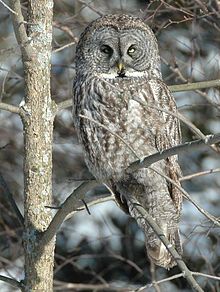| Strix owls Temporal range: Early Miocene to recent
| |
|---|---|

| |
| Great grey owl, Strix nebulosa | |
| Scientific classification | |
| Domain: | Eukaryota |
| Kingdom: | Animalia |
| Phylum: | Chordata |
| Class: | Aves |
| Order: | Strigiformes |
| Family: | Strigidae |
| Genus: | Strix Linnaeus, 1758 |
| Type species | |
| Strix stridula[1] = Strix aluco Linnaeus, 1758
| |
| Species | |
|
See text. | |
| Synonyms[2] | |
|
Ciccaba Wagler, 1832 | |
Strix is a genus of owls in the typical owl family (Strigidae), one of the two generally accepted living families of owls, with the other being the barn-owl (Tytonidae). Common names are earless owls or wood owls, though they are not the only owls without ear tufts, and "wood owl" is also used as a more generic name for forest-dwelling owls.
These are medium-sized to large, robustly built, powerful owls. They do not have ear tufts and most are highly nocturnal woodland birds. Most prey on small mammals, birds, and reptiles.
Most owls in the genus Strix can be distinguished from other genera of owls through their hooting vocalization and lack of visible ears.
The Latin genus name Strix referred to a mythical vampiric owl-monster believed to suck the blood of infants.[3] Although the genus Strix was established for the earless owls by Linnaeus in 1758, many applied the term to other owls (namely the Tyto) until the late 19th century.[4] This genus is closely related to the extinct Ornimegalonyx.
- ^ "Strigidae". aviansystematics.org. The Trust for Avian Systematics. Retrieved 2023-07-26.
- ^ "IRMNG - Strix Linnaeus, 1758". www.irmng.org.
- ^ Jobling, James A (2010). The Helm Dictionary of Scientific Bird Names. London: Christopher Helm. p. 368. ISBN 978-1-4081-2501-4.
- ^ Mlíkovský, Jirí (2002): Cenozoic Birds of the World, Part 1: Europe Archived 2011-05-20 at the Wayback Machine. Ninox Press, Prague. p.217